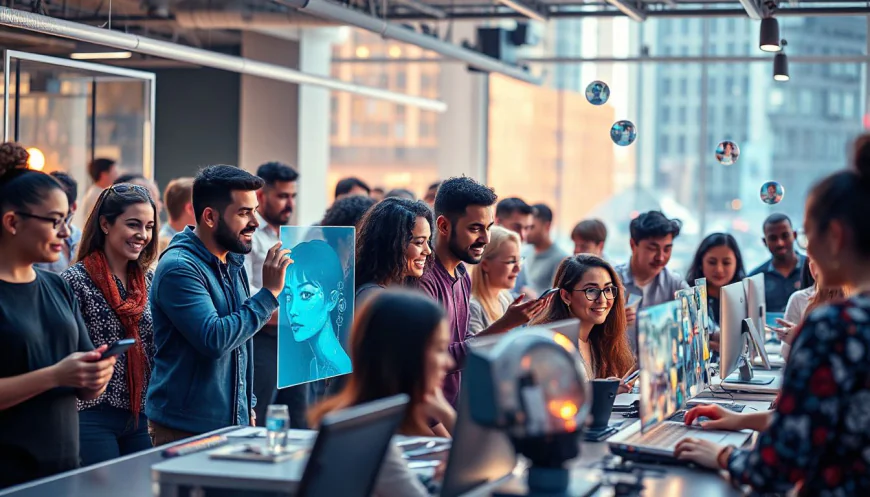AI in the Hands of the Masses: The Democratization of Creativity
Creativity once felt locked behind gates of expertise and expensive tools. Now, thanks to AI, everyone can join in. This shift is changing how we make art, music, stories, and videos. AI isn’t just for experts anymore; it’s for anyone who wants to create. This new wave makes creative tools more open, simple, and truly accessible

The Rise of AI-Powered Creative Tools
The evolution of AI in creative fields
AI has come far. It started with basic algorithms that could generate simple patterns. Now, we have powerful models that can produce detailed images, music, and words. Notable milestones include the release of AI models like GPT-3 and DALL·E, which can generate human-like text and realistic images. These innovations opened doors for new kinds of art and media production.
Popular AI tools accessible to the masses
Tools like DALL·E make it easy to create images from a written description. ChatGPT helps write stories, emails, and even code. Platforms like Canva have added AI features for quick design work. Runway ML offers a friendly interface for video editing and effects. Most of these tools are designed so that anyone can use them, even with no tech skills. Zero-code platforms mean you just click buttons and create.
The role of open-source AI in democratization
Open-source projects like Stable Diffusion give free access to high-quality models. Creators can then customize these models to fit their projects. This makes AI more affordable and flexible. Small studios and hobbyists benefit greatly because they don’t need deep pockets to experiment and produce.
How AI Is Democratizing Various Creative Domains
Visual Arts and Design
AI-generated art is transforming digital creativity. Artists now use AI tools to craft complex images in minutes. Graphic design tasks that used to take hours are now streamlined. Many artists see AI as a partner that pushes creative boundaries. For example, digital artists combine their ideas with AI-generated images to make stunning visuals.
Music and Audio Production
AI makes composing and producing music easier than ever. Thanks to tools like AIVA and Amper Music, you can create melodies without being a professional musician. Platforms like Jukebox by OpenAI produce realistic singing and music tracks. Small bands and indie creators find AI helpful for quick ideas and full tracks alike.
Writing and Content Creation
Bloggers, marketers, and writers now use AI to craft content fast. AI writing assistants help generate ideas, edit texts, or even produce entire articles. It’s like having a co-writer at your side. This democratizes content creation, helping people share their stories without high costs or skills.
Video Production and Animation
AI tools like Synthesia and Lumen5 automate video editing and animation creation. Even deepfake technology has become more accessible. This means making videos with virtual actors or animated characters can be done by small teams or individuals. Video creation is no longer limited to big studios with huge budgets.
Challenges and Ethical Considerations of AI in Creativity
Intellectual property and ownership issues
Who owns AI-created content? Is it the user, the developer, or the AI itself? These questions are under debate and could lead to new legal rules. Recent cases show that courts are starting to figure out how rights work with AI outputs.
Quality control and authenticity
AI can generate fake media that’s convincing. Deepfakes and misinformation pose risks. While democratization boosts creativity, it also demands responsibility. Users should be aware of how AI content can be misused and act ethically.
Bias and inclusivity concerns
AI models learn from the data they are trained on. If this data is biased, the outputs can be biased too. That can impact how inclusive or representative AI-generated art is. Developers need to ensure diverse data to make AI fairer and more inclusive.
The Future of Creativity with AI in the Hands of Everyone
Emerging trends and technological advancements
AI is getting better at blending different media like images, sound, and text. Imagine a single AI that helps you create a song, a video, and a story—all in one. Personalized AI assistants will guide creators, making it easier to bring ideas to life.
Opportunities for individuals and businesses
If you're interested, now's the time to start. You can find many AI tools that help beginners launch projects or small businesses. You might even build a new career as an AI-assisted creator. Small brands can use AI to produce content that looks professional without big budgets.
Actionable tips for aspiring creators
- Explore free or low-cost AI tools like Canva, ChatGPT, or DALL·E.
- Learn about responsible use and avoid making misleading content.
- Share your AI-made work online to connect with others and grow your network.
- Stay updated on new tech developments to keep your skills sharp.
Conclusion
AI has opened the floodgates of creativity. Now, artists, writers, musicians, and video makers can create more now than ever before. It’s clear that AI helps break down old barriers, making creative work more inclusive. But responsibility also matters. Using AI ethically and fairly will help everyone get the most from these new tools. Embrace this change. Let AI be your partner in expanding what’s possible and in sharing your voice with the world.



 VARSHITHA
VARSHITHA